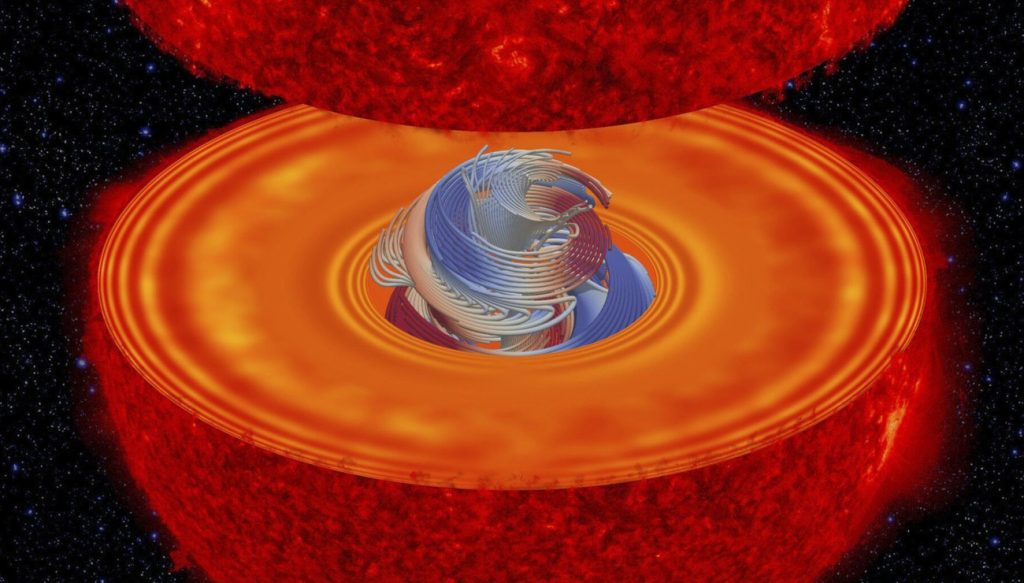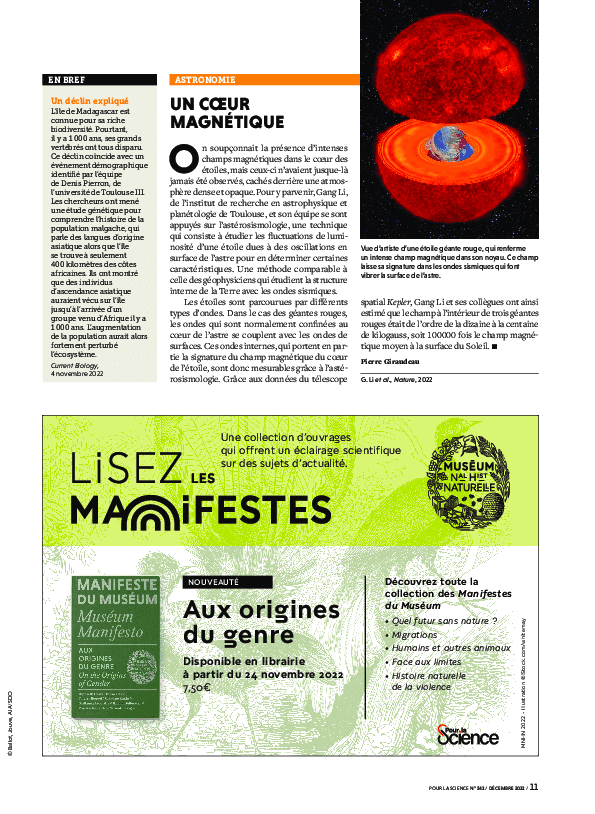Under the influence of plasma movement, stars, like the Sun, produce a magnetic field that plays a major role in the dynamics of their surface and in the formation of stellar winds. But what about the hidden part of the field, the part inside the star? Depending on its intensity and shape, the magnetic field will play an important role in the evolution of the star by actively contributing to the mixing of chemical species present there. However, the cores of stars, where the material is dense and opaque, are not accessible for direct observation, so far only surface field measurements have been obtained. However, one method, stellar seismology, offers the possibility, thanks to the analysis of vibrations that propagate in the star, to investigate in greater depth. Gang Li, of the Toulouse Institute for Research in Astrophysics and Planets, and his team used this technique to highlight the presence of an intense magnetic field in the cores of three red giants.
The red giants are stars at the end of their lives, and most of the hydrogen in their cores has been used up. Thermonuclear hydrogen fusion reactions continue in the atmosphere surrounding the nucleus, which contracts under its own weight. On the contrary, the outer layers are pushed outward, which leads to a strong expansion of these stars and a cooling of their peripheral regions. At the end of its life, the Sun itself will become a red giant and swell until it has at least swallowed Mercury and Venus.
On the surface of these stars, convective motions provoke seismic waves that propagate into the deep layers. These vibrations take the form of longitudinal waves (such as sound waves called “P-mode”) and transverse waves called “gravitational” (“G-mode”) waves. If the first is spread over the surface, then the second is located in the core of the star. Vibrations in the outer layers cause fluctuations in the luminosity of stars. By analyzing this data, astrophysicists determine the internal structure of stars, in the same way that geologists use Earth’s seismic waves to determine the internal organization of a planet.
Red giants are of particular interest: in these stars, pressure waves and gravitational waves combine, which leads to the appearance of the so-called “mixed” patterns, which explore both the core and the atmosphere. By analyzing data collected with the Kepler space telescope, Zhang Li and colleagues identified three red giants whose oscillation frequencies showed subtle anomalies. The researchers showed that the latter is associated with G modes, and bears the imprint of the intense magnetic field in the core of stars. By comparing the data with a theoretical model, the researchers estimated that the field strength was on the order of ten to one hundred kilogas, or 100,000 times the average magnetic field at the surface of the Sun.
Artist’s impression of a red giant star that has an intense magnetic field at its core. This field leaves its mark in the seismic waves that vibrate the surface of the star.
© Ballot, Jouve, AIA/SDO.
Since the first detection of sun-like oscillations on stars other than the Sun in 2000, astronomy has become a formidable tool for analyzing internal stellar structures. With the observations of Zhang Li and his team, seismology now opens the way to a quantitative study of magnetic fields in models of stellar evolution, another step toward a full understanding of the life cycle of stars.

“Music guru. Incurable web practitioner. Thinker. Lifelong zombie junkie. Tv buff. Typical organizer. Evil beer scholar.”








More Stories
Sophie Adino officially receives her “wings” and will be able to fly in space by 2030
Plants grow mostly in the afternoon
Why should we not confuse academic freedom with the autonomy of science?